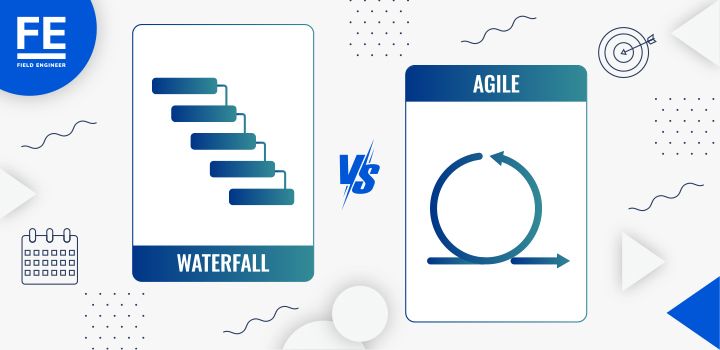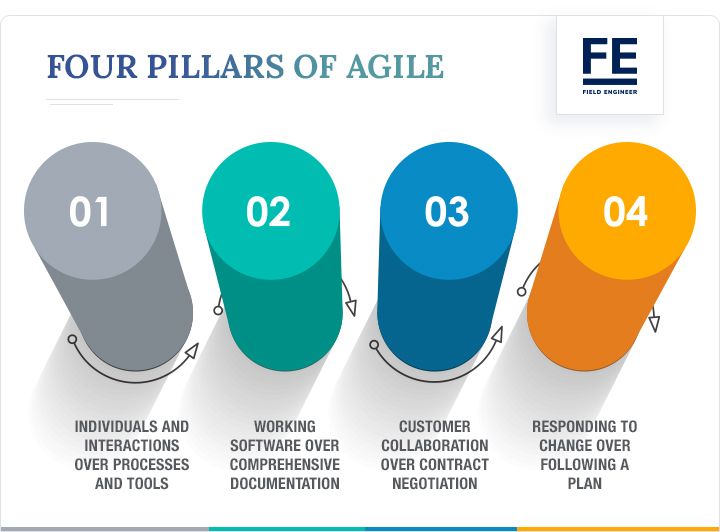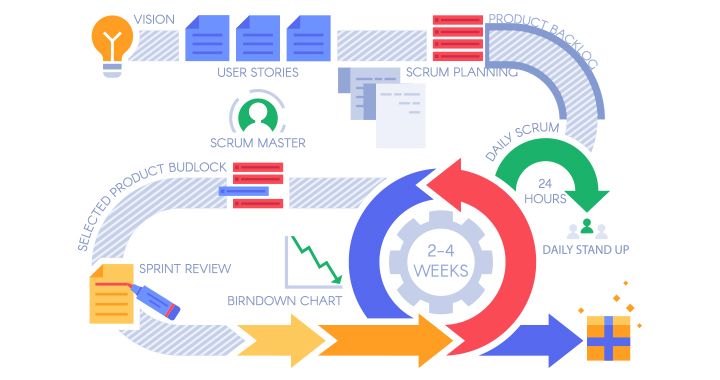Agile Methodologies: The Key to Successful Project Management
Agile is a popular software development approach emphasizing collaboration, continuous improvement, and delivering value to customers. It's flexible, adaptive, and departs from traditional methods. This article explores agile methodologies and their benefits and implementation in various fields.

Are you tired of lengthy and complex software development processes that fail to meet your project requirements? Is your team struggling to meet changing customer needs and market demands? It may be time to consider adopting agile methodologies.
Agile methodologies have gained popularity in recent years as a more flexible and adaptive approach to software development. Agile emphasizes collaboration, continuous improvement, and delivering value to customers early and often. It's a departure from traditional waterfall methods relying on extensive planning and documentation.
In this article, we will explore the concept of agile methodologies, their benefits, and how they can be implemented in different fields. Whether you're a business owner, project manager, or team member, understanding agile methodologies can help you stay competitive and adapt to changing market demands. So, let's dive in and learn more about this innovative approach to work.

What Is Agile Project Management?
Agile project management is a popular method that promotes regular inspections and adaptations. It involves teams of self-organizing cross-functional members who collaborate to develop solutions and requirements. The methodology follows the principles set by the Agile Manifesto, designed by fourteen leading figures in software. This document reflects their collective experience and understanding of the most successful approaches.
Agile methodologies are ideal for creating fast solutions of high quality in development projects as it aligns customer needs with company objectives. This approach emphasizes on creating teamwork, accountability, and self-organization where everyone involved understands their role better. Interestingly, Agile can also be applied to hardware projects regardless of scale or duration. It applies the same principles of early feedback design, rapid output delivery, and close collaboration between teams as with software development projects.

What Are Agile Methodologies?
Agile methodologies are a way of implementing the Agile mindset in a practical, structured manner. These frameworks help teams and organizations implement the Agile principles, providing guidance on tackling tasks efficiently and with quick results. Different Agile methodologies come with their own set of processes and practices, but all strive to reach the same goal — to produce quality products without sacrificing precious time.
What Are The Four Pillars of Agile?
Agile Project Management focuses on quickly adapting to changes to streamline the development process. To attain this goal, four core values act like the pillars of Agile.
Firstly, Individuals and interactions over processes and tools. This means that working together as a team is favored throughout the project management lifecycle instead of simply following a set process or using a specific tool.
The second pillar is - Working Software over Comprehensive Documentation. The focus should be on developing good software quickly rather than spending time going through an extensive documentation process just to demonstrate what has been made.
The third key pillar of Agile Project Management is Customer Collaboration over Contract Negotiation. Customers must actively guide where the software goes rather than having contracts and negotiations define its path from the start.
Finally, Responding to Change over Following a Plan is one of the more important principles in agile methodology since it helps teams react well to changes and adjust their plans accordingly for productive outcomes.
All these values come into play when managing projects under agile methodology and provide support like strong foundation pillars so that teams can excel and deliver results timely and effectively.

How Does Agile Work?
Instead of designing the project to be completed in one go, it's broken up into smaller chunks known as sprints. Each sprint consists of taking on a certain amount of work from the backlog and completing it within a set time frame.
The first step in the Agile process begins with defining the goals of the project, its objectives, and its requirements. This includes input from customers as well as product owners. Then, a list of tasks is created based on these criteria, which will be prioritized according to importance and difficulty.
The team plans each subsequent sprint drawing from this backlog and then works towards completing all tasks over periods of short duration for that particular sprint. During each sprint, there are regular daily meetings where progress can be checked, and any issues can be addressed accordingly.
As new tasks arise throughout the project, they can also be added to the backlog depending on their priority levels. Agile development keeps customer satisfaction at its core through this iterative process while quickly producing efficient and flexible software solutions to changing requirements.
Different Types of Agile Methodologies?
There are several different variations of Agile methodology available, each offering their own advantages and disadvantages. The most common include:
Kanban

Kanban is a visual approach to Agile, making it easier for teams to collaborate and work efficiently. It is based on the concept of continuously improving workflow and provides team members with a clear overview of what’s completed, what needs to be done and how long each task will take. This method helps teams identify potential roadblocks and visualize their progress.
By using digital Kanban boards, online tools are used to represent tasks in different stages within the development process; cards represent each task on a board and stages are shown in columns. As tasks move from the backlog column into different completion states, team members update their card progress accordingly which creates a comprehensive view of where any project stands at any given time.
Overall, Kanban is an effective tool for improving processes among cross-functional teams who need to collaborate on larger projects or initiatives – no matter how complex they may be. In addition to helping teams identify areas of improvement, Kanban also ensures work gets done quickly and accurately without sacrificing quality over quantity.
Scrum

Scrum is an Agile methodology that is often used by small teams, and it involves regular sprints, which are specific lengths of time devoted to a particular goal. The team is led by a Scrum master who removes all obstacles that interfere with the team fulfilling their daily work. During Scrum meetings, the development team can discuss current tasks, roadblocks, and other issues that may arise in the forthcoming sprint.
To start off each sprint, there is a Sprint Planning event where the development team outlines exactly what can be accomplished within this sprint period and how it will be done. At the end of each sprint, there is also a Sprint Retrospective event—basically a review—where all parties can look back at what was learned from the previous session in order to improve and streamline their methodology for better results going forward. This recurrent meeting acts as an important checkpoint to reflect on successes and failings and find ways to refine our processes so that every new sprint becomes easier than before.
Extreme Programming (XP)
Extreme Programming (XP) is an Agile framework that is typically used in software development to help teams collaborate more effectively. It centers around five core values: communication, simplicity, feedback, courage, and respect. The process involves regular releases and iterations similar to those found in daily Scrum standups but with a more technical approach and focus on how things should be achieved.
The communication aspect of XP is essential for success as it enhances collaboration between developers, designers, and the entire team. This type of communication helps move projects faster without sacrificing quality since everyone understands what's expected from them in regard to developing, testing, and delivery processes.
By emphasizing feedback loops within each iteration or release and aiming for continuous improvement, XP keeps teams focused on ensuring the project meets customer requirements while delivering benefits quickly. Its value of courage encourages teams to “fail fast” so that mistakes are caught early, allowing them to shift direction if necessary with minimal disruption. Lastly, respect is important when dealing with customer requests as it calls for open-mindedness when exploring solutions together.
Adaptive Project Framework (APF)
The Adaptive Project Framework (APF) provides a way to structure and manage projects that can be affected by outside sources. This approach helps project teams plan for potential issues and make adjustments quickly. Unlike other project management methods, APF requires regular updates from team members to stay on track with changes in resources. With this method, project goals and scope are determined upfront, while extra resources will be discussed and reviewed periodically.
It is essential for the success of an APF based project to adjust for those changes which occur over time. Resources such as personnel may need replacing or teams may need augmenting; budget savings can become additional opportunities; and risks should be identified early-on and monitored closely.
The key focus is flexibility - adapting quickly to changing scenarios to achieve the desired goals: efficiently, accurately and cost-effectively. By employing this adaptive working system, organizations stand a greater chance of finishing successful projects on time and within their allocated budget; even after any unforeseen circumstances have been accounted for.
Extreme Project Management (XPM)
Extreme Project Management (XPM) is an approach used for tackling complex and uncertain projects requiring high adaptability. In this type of project, no two weeks are the same, and teams must be ready to switch strategies quickly without getting overwhelmed.
The key to success with XPM is flexibility, as each sprint usually lasts no more than a few weeks and that’s not enough time for any detailed planning or too much review. Instead, it encourages trial-and-error approaches, making changes often and quickly while continually self-correcting based on stakeholder feedback.
Due to the agility of XPM, projects may experience more delays at the start due to all the adjustments needed – however, if appropriately embraced will result in faster results further along in the process. Proficient project managers who understand and commit to changing processes until they see successful outcomes are a major asset when working with XPM. Ultimately it is a great strategy for dealing with complexity because it allows companies to stay flexible and focus on what has been proven best at every step of their progress toward completion.
Adaptive Software Development (ASD)
Adaptive Software Development (ASD) is an Agile methodology that allows teams to adapt to changing requirements quickly. This process's main focus is continuously adapting to properly respond to these changes. ASD breaks the development process into three phases; speculate, collaborate, and learn.
This non-linear structure provides the flexibility for these phases to overlap at any given time, meaning that all three may be handled simultaneously. By meshing these individual processes together, it creates an environment where teams can learn and evolve faster than if traditional processes had been used.
This accelerated learning environment can prove invaluable in a constantly shifting technological landscape as teams become more adept at identifying and resolving potential issues before they become larger problems requiring more resources. Performing frequent cycles of adaptation in each of the three phases also helps maintain stability, which ultimately increases the chances of success with projects ongoing over a significant period.
Furthermore, by implementing this process correctly, there will be fewer surprises down the line when requirements shift yet again. Adaptive Software Development allows organizations to stay on top rather than consistently playing catch up within their industry's ever-changing landscape.
Dynamic Systems Development Method (DSDM)
The Dynamic Systems Development Method (DSDM) is an Agile method for software projects that strongly emphasizes the project's entire lifecycle, from planning to implementation. DSDM has chosen an in-depth, conscious and structured approach, unlike other agile methods that are more iterative and flexible. This system focuses on four main phases of development: functional mode or prototype iteration, design and build iteration, delivery, and finally, implementation.
Within each phase, specific objectives need to be achieved for the project to move forward. In functional mode or prototype iteration, the aim is to identify customer requirements through prototyping activities such as brainstorming sessions and focus groups.
The design and build iteration have two distinct steps: defining data structure designs and creating user interfaces that can effectively facilitate an understanding of customer needs. Delivery is the process of developing a product to match functionality specifications, while implementation involves executing both tasks tested with satisfactory results during delivery. All these stages ensure the customer receives quality products adjusted to their necessities within an effective timeframe.
Feature Driven Development (FDD)
Feature Driven Development (FDD) is a project management model combining the best Agile methodology, focusing on the features needed in an end product. It encourages collaboration with customers and stakeholders, gathering feedback to prioritize what features should be developed and outlined into specific steps. This process also allows for frequent iterations and updates, improving flexibility when issues arise, or changes need to be made.
The main goal of FDD is to deliver rapid releases of high-quality software based on customer requirements. There is a focus on short development cycles divided into smaller sub-phases so that progress can be tracked easily throughout the product's lifecycle. Since Customer input is key here, all team members must have clear communication with them during this process.
To ensure success, developers must remain focused on understanding user stories while setting objectives that must be achieved at the end of each work cycle. All these elements make FDD an excellent tool for driving innovation in software development teams by allowing for ever-evolving products with features tailored specifically to customer needs.
Pros and Cons of Agile?
The main benefits of Agile include the ability to adjust to changing priorities, increased project visibility which allows for improved business/IT alignment, and improved delivery speed/time to market when compared with traditional methods. This can also lead to reduced overall project risk due to being able to better adapt to changing project conditions.
On the downside, some organizations may need help with the transition from old school ways of working into something new like Agile. Furthermore, different teams within the organization may have different approaches in their adherence and implementation of Agile, potentially leading to inconsistencies or confusion throughout the entire software development process. Finally, Agile’s methodology requires certain changes in organizational culture, which not all groups may be willing or able to adhere to, and it may take time for them to come around to it.
When Should You Use Agile Project Management?
It’s important to consider which management style will best meet your needs. Agile project management is well suited for projects with unpredictable elements or challenges, as its core tenets emphasize short timescales and continuous delivery. If a team is designing or launching a new product, they’ll need the flexibility to test and iterate quickly to ensure success. Agile also means communication with stakeholders can be streamlined throughout the process.
Traditional project management approaches like Waterfall can be easier in some cases because they make planning and measuring progress easier. That makes it ideal when there are fixed budgets and timelines or when teams are expected to work independently without input from stakeholders. Ultimately, taking the time to assess any needs that might arise during a project can help managers identify early on which approach – Agile or Waterfall – would be better for achieving goals successfully and on time.
What are Agile Best Practices?
Agile project management covers the big picture and small details of any project, ensuring everything runs smoothly and efficiently. It's important to have a set of best practices for efficient and agile project management to ensure all goals are met on time and under budget. One of the most important practices that can be used for creating an effective team is sprint planning.
During these sessions, the product owner presents high-priority features to the team, who then answer questions and develop specific tasks for what will become the sprint backlog. Additionally, agility can be further supported by encouraging self-organizing teams.
This type of structure empowers team members to make decisions on their own and adjust quickly when unexpected changes occur or demands shift. With self-organizing teams, team members are also inspired to offer their services instead of waiting for someone else to assign work.
It's also essential for team members to understand the ultimate goal and value they want to provide customers beyond individual features they deliver. Having this level of awareness amongst all participants serves as a rallying cry for everyone working together in tandem toward success. Agile principles can go a long way toward helping teams uncover new opportunities, stay connected with their users’ needs and listen effectively to feedback from both stakeholders and customers.
Many other Agile best practices can help you optimize each stage of your projects, including those related to planning, development and decision-making. If you're looking at working towards an Agile management certification, you'll get an even deeper understanding of professional Agile practices, which could provide further insight into how you can improve your own management strategies.
With the right attitude towards adopting best practices as well as a crystal clear vision of what success looks like for your end-users, introducing an agile approach can lead your team straight into product success.
Final Thoughts
Agile project management is a great way to ensure teams can quickly and efficiently respond to changing business needs, stay aligned with stakeholders, and produce better products. It requires significant changes in workflows and organizational culture, but when done properly, it can lead to improved delivery speeds and time-to-market.
To maximize the positive impact of agility on their product or service, teams must establish and adhere to core principles throughout their project cycles, including iterating quickly in small increments and understanding the value they want to provide customers. With a crystal clear vision for success and the right attitude towards best practices, introducing an agile approach can lead your team straight into product success.




